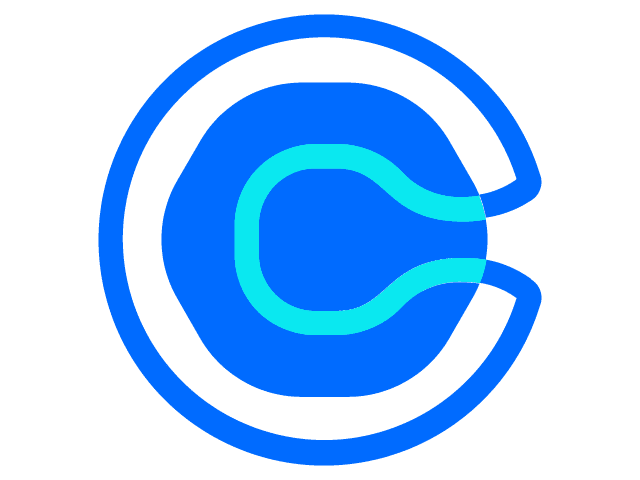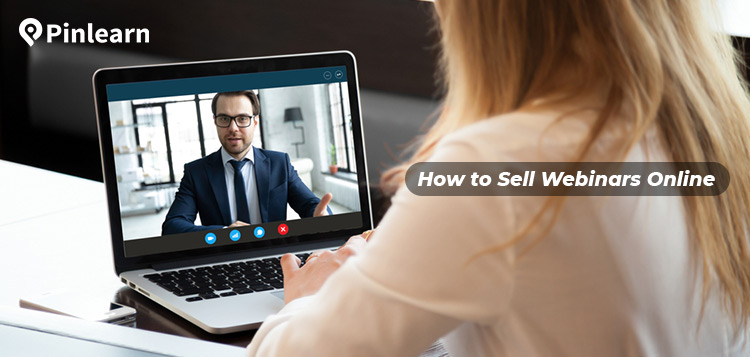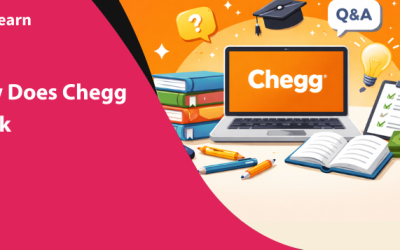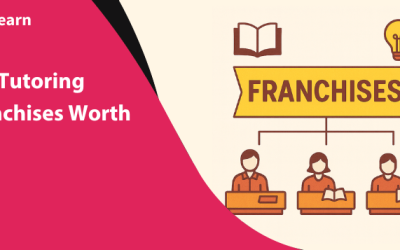How to Sell Webinars Online?
Do you need a powerful marketing tool to educate, engage and convert your audience? If so, you’ve stumbled across the right arsenal to accelerate your business growth.
Webinars have become one of the top e-learning trends in recent times. 91% of B2B professionals consider webinars the most effective content type. But why are we following this webinar evolution?
Let’s answer with a single word—trust! An effective webinar educates the audience and suggests solutions to a prevalent problem, equipping them with upcoming trends. So, there is a seamless thread of trust forged here. And building trust makes those conversions more achievable!
So, whether you are a webinar amateur or just chiseling your presentation skills, this article delves deep into how to sell webinars online!
Why Sell Webinars Online?
Webinars are everywhere! If you haven’t come across a webinar invite by industry experts like Neil Patel, Sam Ovens, Russel Brunson, or any other industry expert, you are living under a rock! In fact, the global webinar market size is expected to reach $2.2 Billion by 2031.
But why do they leverage webinars for marketing?
Webinars are versatile, and you can achieve a lot of things with them. It could be a live Q&A session, demo tutorial, or informative session about emerging trends and technologies.
While the end goal of selling webinars online is business growth, here’s how you can do it along the way :
- Global Reach
Flexibility and scalability to host the webinar from anywhere and cater to a larger audience is one of the key reasons for the emerging trend.
- Educate Audience
An engaging webinar provides an opportunity to educate, provide deep insights and address an existing gap. A win-win situation for the business as well as the audience!
- Cost Effective
While traditional seminars incurs an overhead cost of venue, traveling, logistics, and more, online webinars are cost-effective. The only costs are the equipment, internet, and content creation costs.
- Quality Leads
The majority of B2B marketing professionals consider the quality of webinar leads to be “above average.” Once the webinar is over, you can build your email list and follow up with potential leads.
- Establish Domain Authority
Hosting a webinar session is an excellent way to share expertise, build a resilient relationship and establish yourself as an expert! In turn, you learn about audience preferences and interests and refine your offerings.
- Engagement
For blog posts, social media posts, and paid ads, it’s the content that sells. Webinars create opportunities for live interaction and discussions. Plus, it helps to weave your discussions with interesting stories and actual experiences, humanizing your efforts.
What are the Different Types of Webinars?
Before delving deep into how to sell webinars online, let’s understand the different webinar types you could offer!
- Pre-recorded or automated webinars
As the name suggests, pre-recorded webinars are recorded beforehand to save time and made available anytime. These webinars could be scheduled when needed or sold on-demand, just like the one below. Further, you could even create an evergreen video that stays relevant and drives in a lot of revenue!
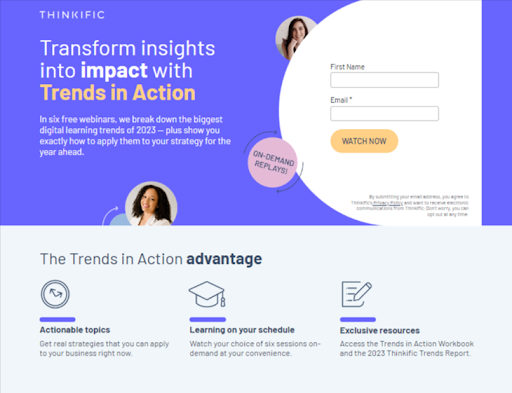
- Live Webinars
This is the most common webinar type, where the interaction happens real-time and involves a live audience. This could be a live Q&A session, discussion, interview, poll, or even an informative session. A quick feedback loop is one of the important points of live webinars!
- Hybrid Webinars
A hybrid webinar is a live session with pre-recorded segments played in between. This approach combines the engagement of live sessions yet enriches your webinars with insightful pre-recorded segments.
Other types of webinars are product, sales, informational, lead generation webinars, etc.
How to Sell Webinars Online: Step-by-Step Guide
Now, you know webinars are an understated tool with the potential to maximize your business growth!
With an effective webinar, you can obviously see the results. And to deliver a powerful session, you need to hit the right notes and resonate with your audience.
Here’s a step-by-step guide on how to sell webinars and directly engage with your customers:
Step 1: Decide Your Goal
First and foremost, before exploring the hows, let’s navigate the whys! By understanding why you are selling the webinar in the first place, you will get a clear picture of how to proceed!
Here are the things you could sell through a webinar:
- Courses or memberships
- Physical products
- Digital products like ebooks
- Coaching Services
- Live workshop or service
Depending on what you plan to sell, setting specific goals for your webinar is essential. Establishing a clear and practical goal helps to streamline how to proceed further.
Let’s say the main goal is to get quality leads, divide them into smaller and achievable goals.
A few of these goals could be:
- Expected number of attendees
- Expected number of registrants
- Remarketing or follow-up goals
- Target number of sales
Addressing the following questions could help you with goal-setting:
- Do I want to expand customer reach?
- Do I want to increase sales to existing customers?
- Do I need to build an email list and target leads?
- Do I want to establish myself as a thought leader?
Answering these questions would help you lay the groundwork for the next steps!
Step 2: Research the Audience
Whether you deliver a live webinar or settle for pre-recorded ones, what matters is that you resonate with your audience!
Research helps you attract the right audience, who could later turn out to be quality leads. So, the initial research is uncompromising!
Analyze their areas of interest, age, location, characteristics, user behavior, job titles, etc.
Here are the popular sources for gathering data for audience research:
- Survey Tools like Google Forms
- Social Media Comments and Reviews
- Customer Interviews
- Industry Research
- Analytics Data
- Emails
- Pre-webinar registration questions
- CRM Data Analysis
Next, segment your audience into important categories like job titles, industry, or expertise. This helps you to find topics tailored to specific segments of audiences.
For example, if you are selling a fitness course to beginners, host a webinar session called “How to Change your Lifestyle and Nutrition Fundamentals.”
Step 3: Brainstorming Ideas for Webinar
Now that you have a better understanding of your audience, you are well equipped to come up with an intriguing topic!
Choose a topic that sparks interest, addresses pain points, focuses on outcomes, and offers valuable insights. The secret sauce is to be super-specific!

Shane Baker from Content Marketing Institute shares an interesting insight on choosing your webinar topic.
Here’s an interesting insight on the same:
Tony Ulwick’s job-to-be-done theory states that buyers aren’t looking for brands or products but rather for practical solutions. So, instead of elaborating on your product’s benefits, explore topics that address the client’s problem and win their trust.
So, informational webinars are a great bet to break into their thought process!
Given below are some engaging and popular topics for every niche:
- Best Practices or How-to-guides
- Prevalent Industry Trends or Recent Updates
- Product 101: Highlighting the Features and Functionalities
- Interactive Q&A sessions
- Case Studies or Success Stories
- Thought Leadership Topics
- Expert Interviews
- Professional Development & Skill- Building
Find a sweet spot between providing value to your audience and connecting it to your sales offering!
Step 4: Create Compelling Content
While detailed research and an interesting topic are essential for a successful webinar, “content is the king!” After all, you don’t want your audience to leave the session halfway, right?
Create an engaging webinar that keeps your audience captivated till the end!
Here are the essential points to consider while crafting your webinar content:
1. Approach
First, determine the webinar approach before moving on to creating content.
Do you wish to deliver a salesy or an informational webinar?
A salesy webinar focuses on converting participants to customers.
On the other hand, when starting out, it’s better to opt for an informational webinar. They focus on offering valuable insights and building trust and rapport with the audience. Such webinars are good to establish a loyal customer base!
2. Webinar Structure
Outline the webinar to identify the essential topics you plan to cover. This will give you a clear roadmap and prevent you from drifting away from the topic!
A big mistake that people typically make is to stuff the webinar with all the information! This could be overwhelming for the audience!
Every webinar has the following key sections:
- Compelling Introduction
Start the webinar with a hook. This could be an intriguing statistic, fact or question that captivates the audience! Give a brief introduction about yourself and speak about your credibility (achievements).
Next, inform your audience about what they will learn, the session duration and how they can leverage the knowledge. You could even offer a bonus or a gift they would receive so that they stay tuned till the end!
- Main Content
This is the crux of the webinar! Break down your topic into the 3-4 main categories and create bullet points about the information you will cover in each section.
Add streaks of storytelling, personal experiences, case studies, and examples to create those intermittent “wow” moments!
One-sided conversations are mundane! Encourage a healthy discussion through discussions, polls, and Q&A sections.
- Effective Call-To-Action (CTA)
Conclude your webinars with a quick summary, interactive Q&A and effective CTAs. Ensure the transition from the core section to your sales pitch is seamless!
Offer a clear post-webinar action plan — whether they should sign up for the course, go through the product demo, etc.
3. Presentation
Powerful slides are effective aids to keep your audience engrossed till the end.
Here are a few tips to enhance your slides:
- Keep the text on your slides to a minimum to make them more engaging and understandable slides.
- Grace up your slides with appealing infographics, images, images, etc.
- Maintain a consistent font style, color scheme and layout that speaks about your brand.
If you are creating a webinar presentation for the first time, this video could help you nail it the first time!
Here’s what you need to consider while choosing your webinar platform:
- Webinar goals
- Polls, Q&A
- High video & audio quality
- Pricing
- Event Size
- Analytics
- Personalized branding
For instance, if you want a solid engagement for your webinars, opt for a platform with excellent chat and communication features.
Step 6: Determine the Monetization Strategy & Setting Price
While free webinars are great to build your email list, paid webinars allow you to monetize your knowledge.
One way is to charge the audience to access your live webinar or recording. You need to offer valuable content, advanced training, or a unique solution to make your webinar worth every penny .
An optimum price is to charge between $49 and $99.
Another strategy is to monetize on evergreen webinars. Let’s say you offer a free digital marketing webinar on “Basics of digital marketing and SEO” first, you could charge for lifetime access to replays.
So, those who couldn’t make it to the webinar can still access your content. Sell a single replay or a bundle.
Other ways to monetize are through paid membership sites, sponsorships, affiliate marketing, donations, etc. Choose a webinar platform that integrates with popular payment gateways. Zoom integrates Stripe, Paypal, Payline, etc.
Step 7: Promoting Your Webinar
A robust promotional strategy holds the key to a successful webinar! You might have the best topic, decked up the best presentation, or even the ultimate product to pitch for! But all this won’t matter if your prospects don’t even reach your landing page!
Let’s take a look at some great marketing strategies worth investing:
- Email Marketing
Webinars and emails are like two peas in a pod!
Emails are the most effective way to promote webinars.From the first promotional mails to the subsequent follow-ups, email sequences provide a seamless workflow to your marketing campaigns.
Here’s an example of an email sequence:
Pre-webinar email sequence:
- Registration mail with webinar details
- Thank you email for registration along with the webinar link
- Value-building reminder emails along with blog posts, ebooks, etc.
- Final reminder emails sent days to hours before the webinar
Post-webinar email sequence:
- Session replay, free product demo links and one-time offers for attendees
- Social Media
People spend 2-3 hours on social media on average. So, they are ideal channels to drive good traffic for your upcoming webinar. You could pepper some great updates and interesting insights related to your webinar topic.
Share links to your webinar landing page across X (formerly Twitter), LinkedIn, Facebook, Instagram, etc. Post in dedicated forums and LinkedIn groups. Include a captivating hashtag to create momentum with your social posts.
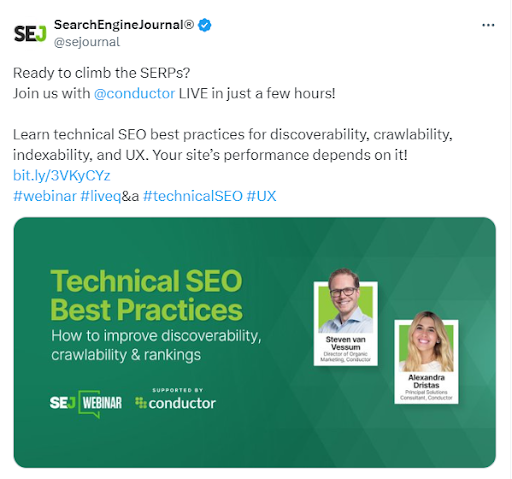
- Content Marketing
Blog posts are an excellent medium for pre-webinar and post-webinar promotions.
Publish interesting blogs related to your webinar and establish domain authority. This could be a how-to-guide, case studies or even interviews with industry experts.
Create an attractive banner and subtly lead your readers to the webinar landing page.
- Paid Ad Campaigns
Organic marketing is ideal for generating quality leads. However, a fleck of paid ads could boost your marketing efforts and help you appear in search queries! Leverage Facebook, Meta, and Twitter Ads to drive top-of-funnel traffic to your webinar page.
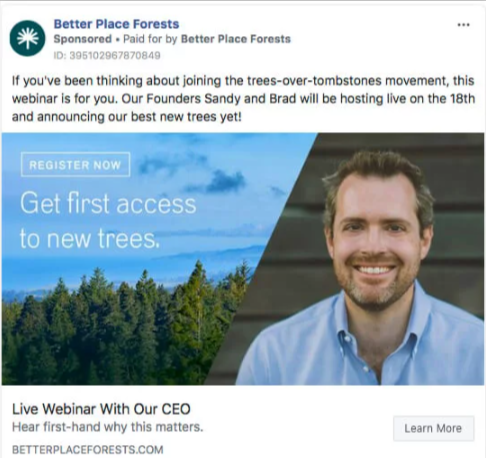
Facebook Webinar Ad
P.S.: Plan your promotions 3-4 weeks before the webinar to drive a lot of traffic and make your efforts worthwhile!
Step 8: Creating an Effective Marketing Funnel
A webinar funnel is a sales funnel that turns a webinar into a high-converting lead magnet.
Here’s how you can do that:
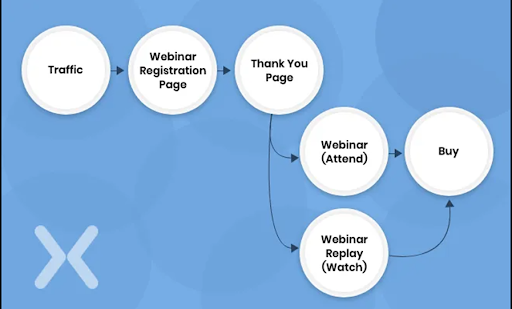
Webinar Marketing Funnel
- Traffic
Drive traffic to the webinar landing page. We have already explained how to do that (step 7) through effective promotions.

- Registration
Website visitors who are interested in the webinar would complete the registration. That’s when you collect their email addresses and build an extensive email list.
- Thank You Page
After the registration, redirect them to a simple thank you page. A simple message like “Thank you for registering” is an excellent acknowledgement. You could even add buttons to share the webinar with the leads’ contacts.
Don’t forget to send a thank you email providing the webinar details. Include the webinar link and mark a calendar link to add the webinar to your preferred calendar.
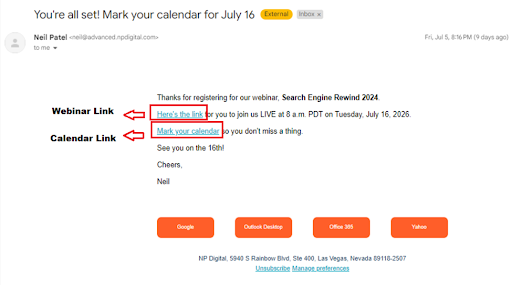
- Hosting the Webinar
Now, it’s time to host the actual webinar!
Make sure your webinar is engaging and offers value to your audience. Even if they don’t buy your offering, they should have a few key takeaways.
Preparation is the key to hosting a stellar webinar. Webinar jitters and anxiety are pretty normal when attempting a webinar for the first time! Practising your slides a few times before the actual event could tame those nerve-wracking thoughts.
Whether you go off script or include polls, maintain the flow of the webinar! For promotions, follow the 80-20 rule: The majority of your webinar should be knowledge-driven, and 20% must involve promotions.
Alternatively, you could also offer an on-demand pre-recorded webinar, where prospects can rewatch specific segments later.
End your webinars with an effective CTA to drive more conversions!
Tip: Ideally, Tuesdays work best for scheduling webinars and drive in around approx. 24% of sign-ups.
- Buy
The final step in the marketing funnel is when your leads convert into actual customers!
Like any other marketing funnel, the number of qualified leads decreases towards the bottom. At the end of the funnel, you’re left with only those who are actually interested in purchasing the product!
Step 9: Follow Up with the Ones Who Didn’t Purchase
You might have given your best shot, but your job doesn’t end with hosting the webinar! Follow-up emails are an unputdownable aid for converting participants into customers!
Send personalized follow-up emails, including summaries, highlights, webinar replays, video sales letters, promotional offers, etc.
Additionally, post-webinar surveys and discussion forums are excellent for nurturing relationships even if you don’t get a purchase!
Tips to Increase Engagement in Webinars
- Define clear webinar objectives and break them into small attainable tasks.
- Use gamified elements like leaderboards, polls, short quizzes, and rewards to keep the audience engrossed.
- Connect different elements of sessions like storytelling, personal experiences and a dash of humor.
- Ditch mundane text-only presentations with audio clips, videos, and infographics.
- Encourage conversations with polls, discussions, and audience spotlights.
- Craft the webinar session based on the audience’s pain points, struggles and expectations.
- Collaborate with influencers and brands related to your niche to usher in new ideas.
Conclusion
Now, you know why experts and professionals rely on the power of webinars to grow business! We hope that after reading this detailed blog, you have a clear grasp of how to sell webinars online.
From analyzing your target audience and delivering a captivating session, to mastering the webinar funnel, there’s much to learn! However, by leveraging the right strategies, devising a clear promotional and follow-up plan, you are sure to win over customers! So, what’s the next big webinar idea you are up to?
FAQ-Related to How to Sell Webinars Online
1. How to sell webinars online?
Determine the intention to sell webinars, understand your target audience, create compelling content, choose the right platform and promote your webinars across the right channels.
2. How do you make money from webinars?
You can charge an entry fee for your webinar, share a demo product tutorial, or sell an online course to earn from webinars.
3. Are free webinars worth it?
Free webinars help expand your reach, engage your audience, build trust, drive conversions, and more. Hence, they are valuable resources in the long run.
